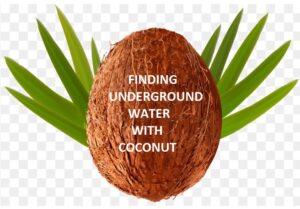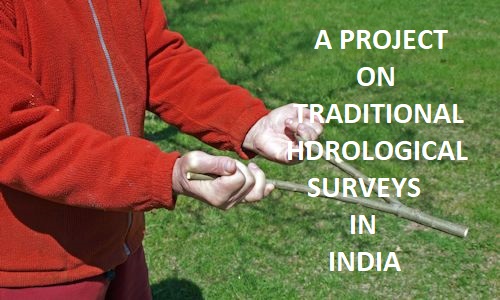Traditional Hydrological Surveys: Merits & Demerits
In India, Traditional Hydrological Surveys play an important role in understanding and harnessing underground water resources. India is a vast and diverse country where both water scarcity and accessibility have significant concerns. Due to non availability of modern technology in rural and remote areas, traditional hydrological methods have been employed to find the underground water. Although these methods have been used for a long time, it may lack accuracy and scientific validations.
This blog article cover different aspects of Traditional Hydrological survey practices for the readers interested in underground water exploration, environmental science and sustainable water management.
Let’s see some of these traditional hydrological survey methods in this blog article.
Traditional Hydrological Surveys Aid In Groundwater Exploration
Dowsing OR Water Divining:
Firstly, Dowsing is an age old traditional hydrological survey method especially in North India.
In this method, you will find a person holding a “Y” shaped stick and walking in the field.
It is believed that where ever there will be underground water, the stick will bend downwards.
People dig there and find underground source of water.
It can be a well, or a bore. As it is done by highly skilled and experienced people, the chances of getting the water source is very high.
That is why it is a very popular traditional hydrological survey method in North India.
Hydrothermal Vents: Formation, Bio-Diversity & Geological Process
Ball Method:
In this method a small hole is dug in the ground.
A pipe or a hollow bamboo is inserted in the hole.
The pipe or the bamboo is half filled with water.
Water level is then observed over a period of time.
If the water level remains constant or it increases, it is assumed to have good source of water underground.
Percussion OR Borewell Soundings:
In this method, people tap on the ground with a heavy object.
The sound produced is heard.
If they here a hollow sound, they predict the source of water.
This is also one of the common traditional methods of detecting underground water.
Observation of Natural Indicators:
Next, the traditional water finders also look on to the natural indicators.
These natural indicators include the movement and the presence of animals.
Also, they look for certain type of plants.
Moreover, they believe that the presence of certain plants and animals are associated with underground water sources.
People those who observe are highly skilled and experienced and sometimes their predictions are accurate.
Oral Histories OR Age Old Methods:
Local communities often rely on oral history to identify potential locations for digging wells or tube wells.
The older people say that observe the water level in the wells in the nearby areas.
Also observe the quality of water coming from the hand pumps.
By observing this, they try to predict the flow of underground water.
As they have been seeing this method used by older people in the village areas, it passes down to the next generation.
The Coconut Version:

FINDING UNDERGROUND SOURCE OF WATER USING COCONUT
Lastly, people also use coconut in finding the underground water sources.
In this method, a person walks on the ground by placing a coconut on his palm.
Where ever, there is a source of underground water, the coconut stands vertical.
This is also one of the common traditional methods of water dowsing in the coastal areas of India.
It is something related to do with the electromagnetic fields as it is believed.
Traditional Hydrological Surveys Aid In Groundwater Exploration
Merits:
Traditional water finding ways often employed in various cultures of the world, have some merits that makes them noteworthy. Of course, these methods may have cultural significance, it is important to note that, these methods are not scientifically proven. Here are several potential merits associated with traditional ground water exploration.
Cultural Heritage:
The traditional methods are often rooted in the cultural believes and practices.
As it passes down through generations, it helps in the preservation of cultural heritage.
Cost Effective:
Traditional water finding tools are very often cost effective.
It requires simple tools such as sticks, pipes or coconut.
Modern and scientific methods of finding water is too expensive as compared to traditional water finding methods.
Relying on local knowledge:
These methods often rely on the local knowledge of an individual or community based on their vast experience and skill.
Eco-friendly:
Modern methods of underground water finding may have adverse effect on the environment but traditional methods are often environment friendly.
Community involvement:
Traditional methods often involve the participation of community in finding water.
This leads to unity, cooperation and involvement and a sense of togetherness.
Adaptability:
Seeing the geographical conditions, local communities often modify their methods based on their specific needs and environmental conditions.
Spiritual and Ritualistic Practices:
Spirituality in south east Asian countries play an important role.
Therefore, some of the traditional water finding ways are related to spiritual and ritual practices.
Although, these practices are not scientifically proven but it reinforces the cultural and social significance of water.
Moreover, it also promotes a sense of reverence for this vital resource.
Traditional Hydrological Surveys Aid In Groundwater Exploration
Demerits:
Traditional water finding methods may have cultural and Historical significance, but they may not be very much reliable. Moreover, these methods are also not scientific. Therefore, these methods also come with certain demerits or drawbacks. Some of the demerits are listed below.
Lack of scientific validity:
One of the most important demerit of traditional water finding methods is it lacks scientific validity.
Moreover, such methods are mainly based on mythological stories, folklore or superstitious beliefs.
Relying on these factors may lead to inaccurate assessment of underground water resources.
Inconsistency and unreliability:
Traditional methods may work for some people but it does not have consistency always.
Change in weather conditions, landscape, flow of underground water, and change in the amount of precipitation may not give accurate results.
Therefore, these methods are unreliable.
Limited Precision:
Traditional methods often fail to provide precise location about the quality, quantity and depth of water.
In todays world, scientific data is much more accurate and can reliable.
Dependency on Local Knowledge:
Local knowledge can be useful for a particular area or to a specific community but, it may not be applicable to other areas.
For example the traditional water finding methods in the coastal areas may not be accurate in plateau or desert regions because of the different
geographic conditions.
Resistance to Innovation:
Traditional methods are mainly based on folklore, local knowledge and spiritual believes.
These methods may hinder the adoption of innovative and advanced technological approaches.
Such methods can impede progress in sustainable water resource development.
Misinterpretation:
The signs and signals used in the traditional method may lead to misinterpretation.
Different people have different perspective. Therefore, they may interpret the same indicators in a different way.
This can further lead to inaccuracy or confusion.
Environmental Impact:
Excessive drilling and digging based on local knowledge or superstitious believes can have adverse impact on the environment.
Traditional Hydrological Surveys Aid In Groundwater Exploration
Conclusion:
Traditional Hydrological surveys are playing an role in finding the underground sources of water. By using techniques such as Dowsing, ball method, Y shaped rod and other traditional methods, have been integral to the rural water management. These traditional methods have helped the communities in identifying potential locations for well, tube wells and bore wells. However, today the modern technology is replacing the traditional hydrological survey methods as it is more scientific, reliable and accurate.
Anyways, water level going below at places like Kalahandi in Orissa, Chhattisgarh, Maharashtra and other western parts of India should be a major concern rather than which methods are used in finding underground water. Therefore, the major focus should be on water conservation methods such as rainwater harvesting and watershed development.
Hydrothermal Vents: Formation, Bio-Diversity & Geological Process





0 Comments